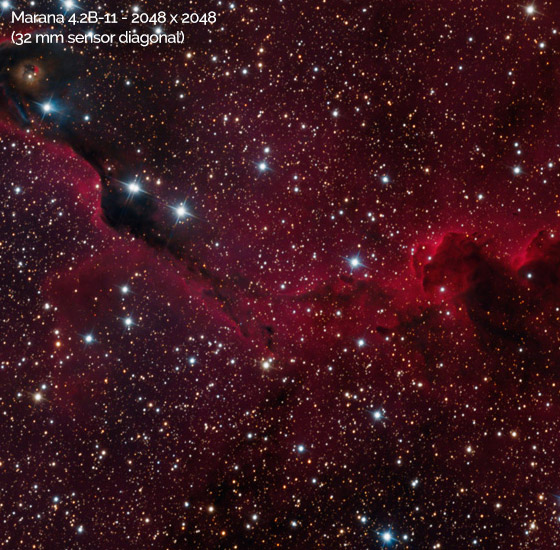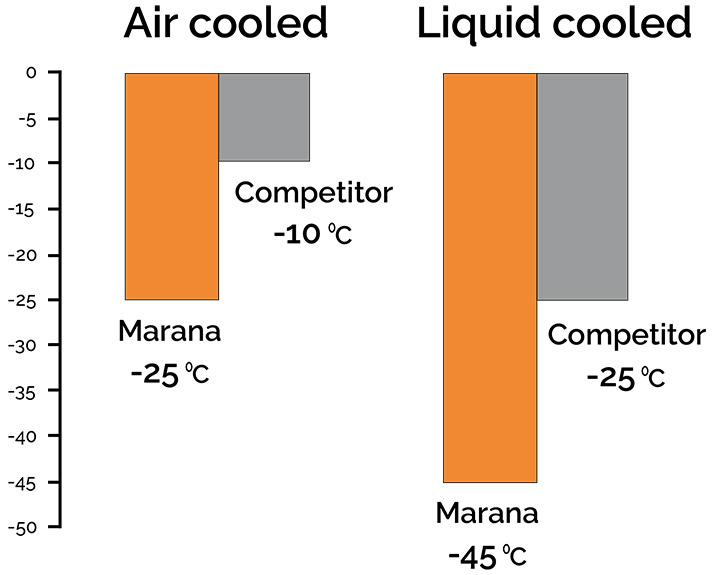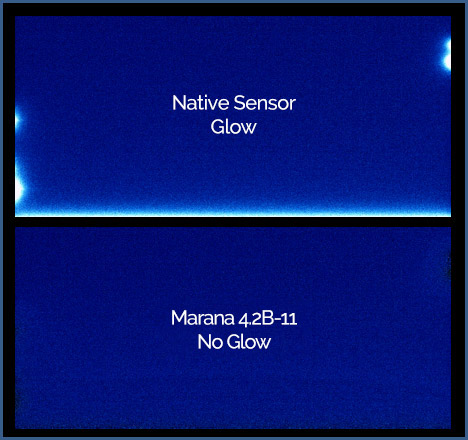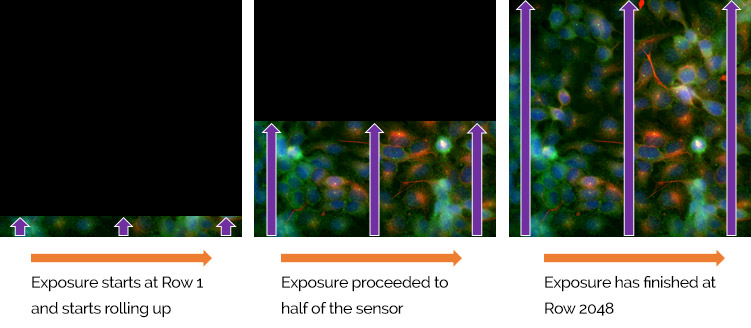Andor Launches Marana
Andor Technology (Andor), an Oxford Instruments company and world leader…
Maranaは、Andor最新の高性能sCMOSカメラプラットホームで、天文学や物理科学への利用に適しています。この度発売を開始した広視野Marana 4.2B-11背面照射sCMOSモデルは、量子効率 (QE) 95%、真空冷却による冷却温度は業界トップの -45 °Cを実現しました。
QE 95%、冷却温度 -45 °C: 超高感度背面照射sCMOSを導入
4.2 メガピクセル / 32mm センサ : 天文学に最適
48 fps フルフレーム(ROIによる高速化): 動きの速い事象をスメアなく追跡
リニアリティ 99.7% 以上: ダイナミックレンジ全域にわたり最高の定量精度
長期の真空度保持および品質確保: センサ表面の湿気ゼロ、QE劣化なし
Maranaは、Andor最新の高性能sCMOSカメラプラットホームで、天文学、ボースアインシュタイン凝縮、量子光学、ハイパースペクトルイメージング、中性子断層撮影、高速分光法などの物理科学分野の幅広い用途に適しています。この度発売を開始した広視野Marana 4.2B-11背面照射sCMOSモデルは、量子効率(QE)95%、真空冷却による冷却温度は業界トップの -45 °C を実現し、さらにピクセルサイズが光子捕捉に最適な11 µmです。 さらに32 mm対角という大型センサーの導入により、高いフレームレートと相俟って、このカメラを宇宙ごみの追跡や地球接近天体(NEO)の検出にも最適なものとしました。
sCMOS感度を究極化するというAndor独自の技術によって、微弱光状態においてもS/Nの最適化を可能とし、その結果、軌道を回る小型物体の追跡、微量濃度の分光検出、原子・イオンの離散量のBEC蛍光検出などに最適なものとなりました。感度が上がるということはすなわち露光時間を短くできるということであり、ダイナミックプロセスに対して48 fps という高フレームレートでの測定が可能となりました。Marana 4.2B-11 はQE曲線の選択が可能で、UVを強化した光源(BU)も選択肢に含めることにより、波長要件が260 nmと400 nmの間にある特定のアプリケーションにまでその用途が拡がります。 ダイナミックレンジを拡げる「デュアルオペレーショナルアンプリファイア」法は、太陽観測や分光材料特性化のように輝度の強弱が極端な領域が混在する難易度の高い場面の正確な可視化や定量化に最適な手法です。さらには、このクラス最高の定量精度を達成するために、Andorは搭載ソフトウェアの強化にも取り組みました。その結果、ダイナミックレンジ全域にわたり99.7%を超える市場をリードするリニアリティを実現しました。これは精密測光にとっても理想的なレベルといえます。


Marana 4.2B-11 は、2048 x 2048 ピクセル全域に有効なアクセスを可能にする独自のアンチグロー技術を活用して、画期的な 32mm 対角センサを導入し、高速フレームレートと組み合わせて天空スキャン天文観測に理想的なカメラを実用化しました。このカメラは高密度マルチファイバハイパースペクトルアプリケーションにも最適です。Maranaプラットホームは、波面補償光学センシングにも簡単に適用可能です。ROIを使用した数百fpsの画像取得が可能なだけでなく、データ転送ラグを最小化する特注設計にも対応可能です。
Marana 4.2B-11 には標準品としてFマウント型アタッチメントが付属しますが、柔軟性を最大化するため、Cマウントアダプタも提供しています(オプション)。アダプタ交換はお客様が簡単におこなうことができ、1400 x 1400 (2 メガピクセル) までのROIサイズに対応可能です。 f/# を抑えた各種のプロフェッショナル用望遠鏡システム用のアタッチメントとして、当社の「お客様の特別リクエスト(CSR)」サービスを利用いただけば、個々の光学ニーズに合わせた特注のマウントフェースプレートの提供も可能です。
95% QE & lowest noise - Maximum signal to noise for light starved measurements. Detect smaller orbital debris; BEC fluorescence.
4.2 Megapixel and 32 mm diagonal - Largest field of view sCMOS, compatible with wide range of acquisition times. Large sky scanning; Tomography.
UV-optimized QE option - Enhanced UV sensitivity between 260 - 400nm. Wafer Inspection (266nm)
Vacuum Cooled to -45 °C - Very weak signals require lowest noise floor and longer exposures: Don’t be limited by camera thermal noise!
The ONLY vacuum back-illuminated sCMOS - Andor's proprietary UltraVac™ technology protects the sensor from moisture and QE degradation over time.
Anti-Glow Technology - Allows access to full array with long exposures - field of view and sensitivity advantages.
48 fps (4.2 Megapixel) - Image highly dynamic scenes without signal smear. Space debris tracking; NEOs.
Extended Dynamic Range mode - 'One snap quantification' across a 53,000:1 signal range - perfect for Photometry
> 99.7% linearity - Market leading quantitative accuracy over the whole signal range
Superfast Spectroscopy Mode - On-head vertical pixel binning, ideal for dynamic spectroscopy (up to >24,000 spectra/sec).
Adaptive Optics mode - Minimize lag after data collection - transfer of row data immediately after exposing.
User configurable ROI - Image only what is necessary. Accelerate frame rates and save data storage space.
Fan and Water cooling as standard - Water cooling for maximum sensitivity.
USB 3.0 (also called USB 3.1 Gen 1) - A convenient, universally available high speed interface
| Key Specifications | |
| Sensor Type | GPixel 400 back-illuminated |
| QE Options | BV, BU |
| Active Pixels | 2048 x 2048 |
| Sensor Size | 22.5 mm x 22.5 mm (32 mm diagonal) |
| Pixel Size | 11 μm |
| Pixel readout rate | 200 MHz (12-bit mode) 100 MHz (16-bit mode) |
| Read Noise | 1.6 e- (median) |
| Maximum frame rate | Marana 4.2B-11 - 48 fps (12-bit); 24 fps (16-bit) |
| Maximum Quantum Efficiency | 95% |
| Dark current, e-/pixel/sec at -45°C | 0.2 |
| Readout modes | Rolling Shutter |
| Pixel well depth | 85,000 e- |
| Maximum dynamic range | 53,000:1 |
| Linearity | > 99.7% |
| Photon Response Non-Uniformity (PRNU) | < 0.5% |
| Data range | 12 bit (fastest frame rates) and 16 bit (max dynamic range) |
| Interface | USB 3.0 |
The Most Sensitive Back-illuminated sCMOS Available

Marana 4.2B-11 back-illuminated sCMOS features 95% Quantum Efficiency (QE) with market-leading vacuum cooling to -45 0C. Benefiting from a unique vacuum design, Marana thermoelectrically cools to -25 0C using only the internal fan for heat dissipation, pushing down to a hugely competitive -45 0C utilizing liquid assisted cooling. The darkcurrent of the GS400 BSI sensor is a significant contributor to overall system noise, so effective cooling becomes essential. With air cooling, Marana has almost 5x lower darkcurrent than the nearest physical science competing camera.
Having the most sensitive Back-illuminated sCMOS camera carries a host of practical advantages within Astronomy and Physical Sciences, for example:

Anti-Glow: Accessing the Entire Sensor Array
The GSense400 back-illuminated sensor from GPixel is widely recognised to suffer from glow at the edges of the sensor. This glow manifests as false signal and is exposure dependent. The approach so far has either been to (a) live with the glow; (b) only use the middle region of the sensor; or (c) firmware restrict exposure times to 30 milliseconds in order to contain the impact of glow on experiments! Either way, this fundamentally restricts performance and usefulness across a range of applications, either through field of view limitation or through sensitivity limitation.
Andor have studied and characterised this sensor issue in detail and have developed and implemented a unique anti-glow technology to radically suppress the sensor glow effect. The figure below shows a dark image of the GSense400BSI back-illuminated sensor with and without anti-glow technology – the difference it makes is stark and has enabled Andor to open up the full 2048 x2048 array, while also allowing exposure times up to 20 seconds.
Extended Dynamic Range and Superb Linearity
The innovative Dual Amplifier architecture of sCMOS sensors uniquely circumvents the need to choose between high or low gain amplifiers, in that signal can be sampled simultaneously by both high gain (low noise) and low gain (high capacity) amplifiers. As such, the lowest noise of the sensor can be harnessed alongside the maximum well depth, affording widest possible dynamic range. Uniquely for such a relatively small pixel design, this allows for dynamic range performance of 53,000:1 in Marana.
Furthermore, on-camera intelligence delivers a significant linearity advantage, providing unparalleled quantitative measurement accuracy across the full dynamic range.

Fast Frame Rates
The sCMOS sensor in Marana 4.2B-11 has highly parallel readout architecture, facilitating high data readout rates and therefore fast frame rates. All columns possess their own Amplifier and Analogue to Digital Converter (ADC), meaning that all columns are read out in parallel.
Marana 4.2-11 offers fast frame rate capability, rendering it ideal for dynamic applications while avoiding motion smear, applications such as Space Debris and NEO tracking, Pulsar imaging, Solar polarimetry, Lucky imaging/Speckle Interferometry and BEC dynamics. Region of Interest (ROI) and 12-bit readout mode can be utilized to considerably boost frame rates further.
12-bit mode for 2x speed boost! Marana 4.2B-11 is architected to offer both 16-bit and 12-bit modes. 12-bit is selected specifically to accelerate frame rate by 2x, while sacrificing wide dynamic range, useful for imaging fast phenomena that are exclusively low light, such as following BEC dynamics on discrete numbers of fluorescent cold atoms.
| Max Frame Rate (fps) | Marana 4.2B | |
| ROI Size (W x H)) | 16-bit | 12-bit |
| 2048 x 2048 | 24 | 48 |
| 1608 x 1608 | 30 | 61 |
| 1410 x 1410 | 35 | 69 |
| 1200 x 1200 | 41 | 81 |
| 1024 x 1024 | 48 | 95 |
| 512 x 512 | 95 | 190 |
| 256 x 256 | 190 | 378 |
| 128 x 128 | 378 | 750 |
| 2048 x 8 | 5415 | 9747 |
| 1200 x 8 | 5415 | 9747 |
Rolling Shutter and Simulated Rolling Shutter
Marana 4.2B-11 utilizes a Rolling Shutter exposure mechanism. Rolling shutter essentially means that different lines of the array are exposed at different times as the read out ‘wave’ sweeps through the sensor, a row at the bottom starting the exposure approximately 21 ms before rows at the sensor’s distal edge. The lowest readout noise and fastest frame rates are available from this mode. Rolling shutter only presents an issue when imaging relatively large, fast moving objects within the field. Then, aside from the risk of motion blur that can affect any imaging condition in which rate of motion is being temporally under-sampled, there is an additional possibility of rolling shutter spatial distortion. However, distortion is less likely when relatively small objects are moving at a rate that is being temporally oversampled by the frame rate, which in fact describes the vast majority of use cases.

A further potential downside of rolling shutter is that different regions of the exposed image will not be precisely correlated in time to other regions, which can be essential for some applications. For example, if a cell is electrically stimulated and it is important to measure the onset of calcium sparks relative to the stimulation event, then rolling shutter should not be used. In this case, a true global shutter mode is required, available in Zyla 5.5 and Neo 5.5 sCMOS cameras.
Multiple Optical Mount Options

Marana 4.2B-11 ships as default with standard F-mount optical coupling, however, the user can readily convert the camera for use with either C-mount or T-mount lenses, simply by selecting these additional optical mount accessories at time of order. C-mount may be used with cropped sub-array sizes up to 1400 x 1400, yielding a 22mm sensor diagonal.
For attachment to various professional telescope configurations, the camera front end can be direct mounted, providing f/# 0.7 with 72° cone angle. Through engagement with Andor’s Customer Special Request (CSR) service, custom mount faceplates can be tailored to your specific optical needs.
Fast Spectroscopy Mode
Marana 4.2B-11 can be readily adapted to the needs of fast spectroscopy, yielding up to greater than 24K spectra/sec. Such spectral rates are ideal for following fast reaction dynamics on sub-millisecond stopped flow timescales. Fast spectral kinetics capability can also be used for ‘pseudo-gated’ time-resolved functionality, whereby the first series of spectra from a fast series can be discarded to ‘gate out’ the effects of the initial exciting laser pulse.
On-camera FPGA real time asymmetric pixel binning allows for optimized optical matching and maximum photon collection, while a complimentary on-camera bit depth of 32-bit capability allows for very high binned effective well depths, ideal for fast transient absorption measurements.
Spurious Noise Filter
Andor’s Marana sCMOS camera comes equipped with an in-built FPGA filter that operates in real time to reduce the frequency of occurrence of high noise pixels. This real time filter corrects for pixels that would otherwise appear as spurious ‘salt and pepper’ noise spikes in the image.
The appearance of such noisy pixels is analogous to the situation of Clock Induced Charge (CIC) noise spikes in EMCCD cameras, in that it is due to the fact that we have significantly reduced the noise in the bulk of the sensor that the remaining small percentage of spuriously high noise pixels can become an aesthetic issue. The filter employed dynamically identifies such high noise pixels and replaces them with the mean value of the neighbouring pixels.
FPGA Timestamp
The Marana platform can generate a timestamp for each image that is accurate to 25 nanoseconds. Accurate timestamps can be important where precise knowledge of frame time impacts temporal dynamic analysis. This is especially important for fast events, where computer and interface latencies need to be considered, for example in Pulsar studies.
Flexible pixel binning
The Marana models feature on-camera flexible pixel binning, user definable to 1 pixel granularity. Greater binning flexibility can be useful for some photon starved applications where resolution can be sacrificed in favour of enhanced photon collection area per pixel - e.g. extremely low light luminescence experiments.
GPU Express
The Andor GPU Express library has been created to simplify and optimize data transfers from camera to a CUDA-enabled NVidia Graphical Processing Unit (GPU) card to facilitate accelerated GPU processing as part of the acquisition pipeline. GPU Express integrates easily with SDK3 for Andor sCMOS cameras, providing a user-friendly but powerful solution for management of high bandwidth data flow challenges; ideal for data intensive applications such as Light Sheet Microscopy, Super-Resolution Microscopy and Adaptive Optics.